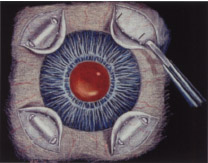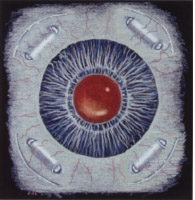Surgical Reversal of Presbyopia
CHAPTER CONTENTS
Surgical Reversal of Presbyopia
Ideally, visual function after age 40 would allow individuals to have excellent unaided distance and near vision with identical distance and near focal points in each eye. This level of visual function is what non-presbyopic emmetropic patients enjoyunifocal vision (symmetrical focal points for each eye) with variable focality (the ability to focus distant, intermediate, and near targets). Presbyopic individuals do not have this level of visual function.
If any refractive error has defied surgical correction to date, it is presbyopia. Options for management include
- spectacles (bifocal, trifocal, progressive, and reader)
- contact lenses (monovision, bifocal, and multifocal)
- intraocular lenses (IOLs) (monovision, multifocal, and accommodating)
- corneal refractive surgery (monovision or multifocal ablations)
In general, none of these options are universally accepted by all patients. A majority of the population may tolerate each technique, but significant proportions of the population do not fully accept them.
MONOVISION
The most commonly performed technique for managing presbyopia has been the induction of monovision (the intentional targeting of a small amount of myopia in one eye to facilitate near and intermediate visual tasks).
Advantages
- patient satisfaction of about 50% (tolerance by 25-30% and the remainder abhorrence)
Disadvantages
- spatial “dizziness”
- nausea
- distance blurring
- night time glare, halos, or starbursting
- depth perception difficulties
MULTIFOCAL APPROACHES
- multifocal contact lenses
- bifocal contact lenses
- multifocal ablations
Advantages
- greater range of useable visual acuity over far, intermediate, and near distances than monofocal corrections
Disadvantages
- ghost images
- glare
- haloing
- worsening of visual disturbances in low-light situations
- an unacceptable trade-off between greater range of focus and slightly reduced best acuity at a distance and near compared with monofocal options (for some patients)
ACCOMMODATING TECHNIQUES
Accommodating techniques such as pseudophakic accommodating IOLs are currendy being investigated. The work is in the very early stages, but this type of correction would allow for a unifocal lens with variable focality.
SURGICAL REVERSAL OF PRESBYOPIA
Ronald Schachar, M.D., developed a technique for the surgical reversal of presbyopia (SRP) using scleral expansion band segments.
In theory, this method facilitates accommodation without compromising distance uncorrected visual acuity (UCVA). Schachar’s surgical procedure is designed to expand the diameter of the eye overlying the ciliary muscle.
Theories of Accommodation with Presbyopia
Schachar’s model for the loss of accommodation with age diametrically opposes Helmholz’s theory. However, recent experimental evidence that supports Helmholtz’s original theory challenges Schachar’s theory.
Helmholz’s Theory
- The crystalline lens loses its flexibility.
- The lens does not increase its converging power with relaxation of the ciliary muscle to facilitate near-vision tasks as it did before age 40.
Schachar’s Theory
- Presbyopia with age results from physiologic growth of the crystalline lens of the eye (Fig. 19–1).
- The increase in the size of the crystalline lens reduces the distance between the edge of the crystalline lens and the ciliary muscle.
- The ciliary muscle, which changes the shape of the crystalline lens by traction on the zonules, is unable to exert sufficient force to alter the shape of the lens.
- When this area expands it increases the distance between the ciliary muscle and the edge of the crystalline lens, permitting the ciliary muscle to exert more force on the lens, thus reestablishing accommodation.

Preoperative Considerations
Indications and Inclusion Criteria
- presbyopia
- healthy conjunctiva and sclera
- near emmetropic refractive error
Exclusion Criteria
- thin sclera
- cataract (cataract surgery should be performed when appropriate instead of scleral segment implants)
- a glaucoma-filtering bleb
Patient Evaluation
- Complete the standard refractive surgery evaluation per Chapters 4 to 7.
- We anticipate that the candidate is emmetropic for distance correction.
- Perform slit-lamp evaluation.
- Ensure that no scleral thinning is present.
Surgical Considerations
Methods
- Perform the surgery in an outpatient setting.
- Administer an oral systemic sedative (Valium or Versed).
- Mark the limbus at the 12:00 position.
- Prepare the skin with betadine.
- Administer topical proparacaine 0.5%.
- Drape the patient.
- Insert the speculum.
- Mark the cornea at 45-degree meridians.
- Make 5-mm arcuate conjunctival incisions 5.0 to 5.5 mm posterior to the limbus and centered at the 45-degree meridians.
- Dissect down to the bare sclera.
- Make two 900-μm-long, 300-μm-deep partial thickness incisions radially in each 45-degree meridian with the PRESBY (Presby Corpration) square guarded incisional diamond knife.
- Make the two incisions parallel to each other and separated by 4.5 mm.
- Straddle the incisions over the selected 45-degree meridian.
- Use a PRESBY lamellar diamond knife to create a scleral “belt loop” (900 μm wide and 300 μm deep) between the two radial incisions.
- Insert the PRESBY scleral segments in each quadrant (Figs. 19-2 and Figs. 19-3).
- Close the conjunctival incisions with 10-0 suture.
- Place one drop of pilocarpine 2% and two drops of a combination antibiotic steroid (e.g., Tobradex; Alcon, Forth Worth, TX) on the cornea.
- Administer 500 cc of intravenous mannitol (Osmitrol or Mannitol; Abbott Laboratories, Abbott Park, IL) within 30 min to shrink the vitreous volume and prevent marked rise in intraocular pressure after surgery.
- Place one drop of pilocarpine 2% and two drops of a combination antibiotic steroid (e.g., Tobradex; Alcon, Forth Worth, TX) on the cornea.

Figure 19-2 Insertion of band segment into “belt loop.”

Postoperative Considerations
Complications
- infection
- implant extrusion
- persistent conjunctival defect over implant
- scleral erosion
- anterior segment ischemia
Patient Care and Follow-Up
- Instruct the patient to use a topical antibiotic-steroid for 7 days and artificial tears and a lubricating ointment before sleep for at least 3 weeks.
- Remove nonabsorbable sutures that were used to close the conjunctiva 7 days postoperatively.
- Advise the patient to avoid eye rubbing.
- Instruct the patient to do pencil pushup and accommodative exercises daily.
Suggested Readings
Glasser A. Can accommodation be surgically restored in human presbyopia? Optom Vis Sci. 1999;76:607-608.
Glasser A, Kaufman PL. The mechanism of accommodation in primates. Ophthalmology. 1999;106:863-872.
Schachar RA, Cudmore DP, Black TD. Experimental support for Schachar’s hypothesis of accommodation. Ann Ophthalmol. 1993;25: 404-409.
Schachar RA, Tello C, Cudmore DP, Liebmann JM, Black TD, Ritch R. In vivo increase of the human lens equatorial diameter during accommodation. Am J Physiol. 1996; 271:R670-R676.
< div class='tao-gold-member'>



